
Thank you for visiting HOJO website. If you have any enquiry, please feel free to get in touch with us at
▼ Akira Hojo
▼ Hojo Newsletter
▼ HOJO FACEBOOK





HOME > Oolong Tea >Tie Guan Yin Lan Yun
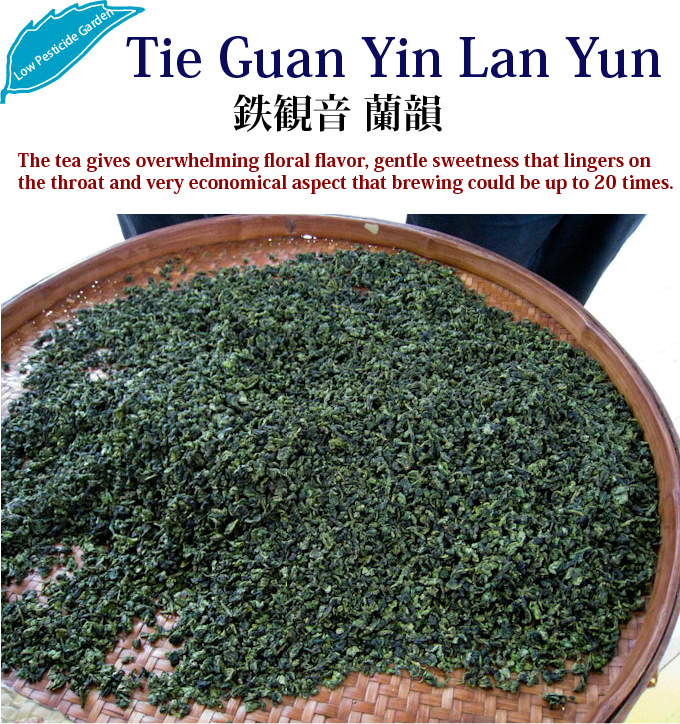
Anxi’s famous tea is Tie Guan Yin. The name of Tie Guan Yin is originally referring to a specific cultivar. In a way, Tie Guan Yin is the oolong tea produced from Tie Guan Yin cultivar. In other context, some may name a tea as Tie Guan Yin on the assumption that tea was produced with the standard method of making a Tie Guan Yin tea. Under the circumstances, other tea cultivars are often processed and sold as Tie Guan Yin. Nevertheless, we only search for the tea made of Tie Guan Yin cultivar, as it is originally defined.
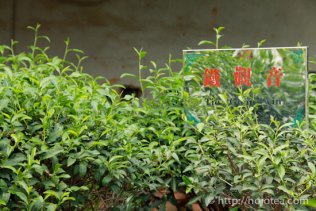 |
 |
|
|
The tea leaves of Tie Guan Yin cultivar |
The tea garden in Anxi for Tie Guan Yin |
In Anxi, Tie Guan Yin was invented during Qing Dynasty. Beforehand, other types of tea like white tea and green tea had been produced. Tie Guan Yin is one of the most famous types of Chinese tea and has been very popular for centuries. No doubt that Tie Guan Yin tea can be found in the menu of most Chinese restaurants throughout the world. Other than the huge demand of Tie Guan Yin in the world’s tea market, this tea is often sought after in China domestic tea market, not only for own consumption, it is one of the top-listed teas as the gift tea in many occasion.
The massive market demand has driven the vast production of Tie Guan Yin tea. The production is carried out all year round, starting from spring to winter. Without the application of pesticide and fertilizer, it's hard to manage the output to meet the demand of the market. Thus, despite the output is huge, we faced difficulty in obtaining the quality tea that complies with Japan pesticide standard. After all, we only selected a limited quantity of spring tea that complies with the standard.
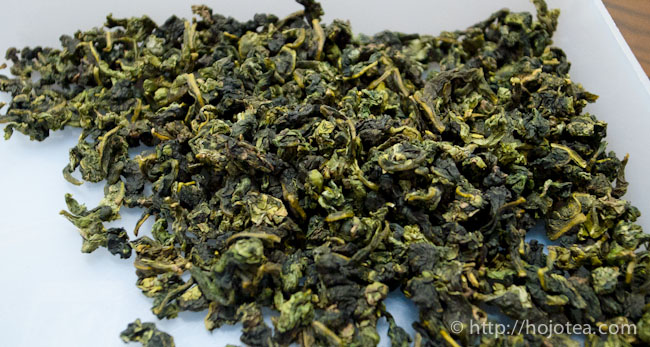
The technology in making Tie Guan Yin was handed over from Wuyi area. Originally, Tie Guan Yin was also heavily baked just like Wuyi oolong tea. However, nowadays Tie Guan Yin that was not baked becomes more popular. The non-baked type is called Qing Xiang (or sometimes it’s called Green Type), and it is vivid green in colour.
Some tea books often describe that the flavour of Qing Xiang Tie Guan Yin reminds us of orchid bouquet. To me, its aroma is somewhat fruity, like fresh young peach.Tea liquor is bright and clear, with light yellowish green colour. Anyone who tried the Qing Xiang Tie Guan Yin for the first time will be surprised by its strikingly intense flavour. It is hard to believe that its flavour is natural and produced from the process. Quite a number of tourists fell in love with Chinese tea just because they tried Qing Xiang Tie Guan Yin during their visit in China.
Many people say that modern Tie Guan Yin is just like the green tea because of the dry leaf is greenish in colour.
However, this is absolutely wrong judgement. In fact, Tie Guan Yin is a highly fermented tea despite its colour is green.
In Anxi, tea starts sprouting in March. During this period, most of teas in China is plucked and processed.
However, Tie Guan Yin is not plucked in March or April. The plucking is carried out only when the tea is grown-up and matured. By that time, the leaf becomes very big and stiff.
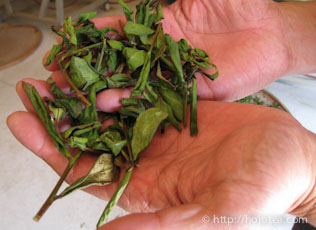 |
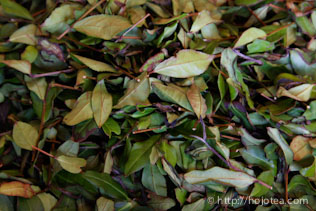 |
|
|
The very grown up twigs are used for making Tie Guan Yin. |
The leaf during fermentation |
When Tie Guan Yin leaf is plucked in May, no bud remains and the colour of stem turns from green to reddish brown. It is literally a branch. In order to produce the specific flavour of Tie Guan Yin, it is necessary to include the grown-up branch together with the leaves. These grown-up leaves are very rich in polyphenols, while upon fermentation, it produces typical Tie Guan Yin flavour. Besides, with higher content of polyphenol, tea contains more minerals. This is why Tie Guan Yin relatively gives stronger aftertaste than ordinary oolong tea.
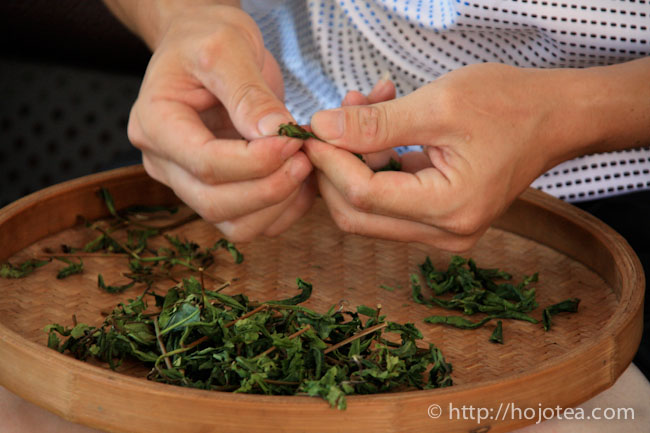
In the long run, you may observe a thick layer of scale accumulated inside your kettle. Our mother usually taught us to wash and remove it with citric acid. But please do not even try to remove the scale. Scale consists of minerals that exist in the water. The mineral composition is reflected from the water you used. If you remove the scale, the mineral ion balance between scale and water is destroyed. This balance is called buffer effect in science. The flavor and taste will seriously run out and you won’t be able to get previous taste and flavor for a long time. It is also important to stick to the same type of water whenever brewing tea. If source of water is changed, it carries different type of minerals. It will affect the mineral ion balance too.
Go to further information about suitable water for brewing tea >>
To determine the quantity of tea leaves to be used, we divide the volume of water by 50. For example: the volume of teapot = 200ml; 200ml/50 =4g. You need to measure 4g of tea leaves for 200ml of water.
Based on the above ratio between hot water and the weight of tea leaf, the brewing time is as follow.
Rinse 1 or 2 times spending 3-4 seconds for each.
1st Brew for 10-20 seconds.
2nd Brew for a few second.
3rd onwards: Brew for a few seconds.
Note: Please remove the lid while you are waiting for subsequent brewing. Tea leaf will be over steamed and get oxidized if the lid is not removed.
In order to enjoy oolong tea, always ensure that the water temperature is very hot. Use boiling water and rinse tea pot with boiling water to keep it hot.
Once a bag of tea is opened, please finish it within 3 months if you wish to enjoy its freshness. From the medical point of view, it is safe to consume the tea even if it is kept for a few years. However the freshness disappears if it is kept for too long. Tea must be tightly sealed before it is kept. Tea should be kept in ambient and dry conditions such as in the living room, but it must be completely away from humidity. Tea should not be kept in the kitchen as the environment is very humid. Avoid enclosed area such as inside the cupboard or drawer as these places are damp. Also avoid opening the bag of tea in humid atmosphere. It is recommended to open the bag during a sunny day or under air-conditioned atmosphere. Once tea leaves absorb moisture, deterioration of tea will be triggered within a few days. Tea will then give an astringent taste, sometime it tastes sour. The fresh aroma also becomes weaker.
The quality of tea lasts longer if it is kept in the fridge. However we strongly recommend you not to keep tea in the fridge. When tea is withdrawn from the fridge, there is usually condensation. Once tea is exposed to moisture during condensation, the quality will deteriorate within a few days. The higher moisture content in the tea leaves will trigger oxidation and it will completely destroy the quality of tea.
Here’s one frequently asked question: what happens if bag is sealed using tape or tea is packed in zipper bag and kept inside the fridge?
For your information, these simple sealing methods are not sufficient. When the bag is withdrawn from the fridge, it is cold inside the bag and therefore causes negative pressure. Air will be drawn from outside and condensation will occur. In addition, if the bag is taken in and out from the fridge very often, this will cause heat stress to the tea leaves as temperature is increased and decreased very frequently. If tea is kept in the fridge, when it is withdrawn from the fridge, it is necessary to leave it in ambient atmosphere for more than 24 hours in order to warm up the tea leaves. Based on our experience, 12 hours is not long enough. We may think tea is warmed up, but inside the bag, the tea leaves are still cold due to insulation effect.

Please feel free to send us e-mail for enquiry at:

 |
We accept various kinds of credit card through Paypal.
Only if customer prefer other option of payment, we suggest "Bank Transfer".
Various choice of shipping method
EMS, SAL, Small Packet, Small Packet (SAL) Yamato Express and Surface
For shipping tea, we usually suggest small air parcel, the estimated shipping cost of tea in 100g (with wrapping material ) is
Small Parcel
USA JPY 600, EU JPY600 and Asia JPY470
Small Packet (SAL)
USA JPY380, EU JPY380 and Asia JPY320
The shipping fee to oversea by small air parcel happens to be even cheaper than domestic shipping fee in Japan.
For your information, some countries, EU in particular imposes custom duty. We need buyer to bare the duty. We are sorry, but we cannot change the amount on the invoice, and we do not mark any packages as gifts. We will strictly follow the custom regulation.
A GIFT FROM THE MOUNTAIN
since 2006
Copyright (C) 2006-2007 HOJO co.,ltd. All Rights Reserved.